Key takeaways:
- Effective collaboration requires open communication, trust, and regular check-ins between designers and developers to align visions and enhance teamwork.
- Involving developers early in the design process helps identify potential technical limitations, reducing miscommunication and the risk of costly revisions.
- Utilizing tools like Figma and Trello streamlines workflows, facilitates real-time feedback, and fosters a sense of ownership among team members.
- Establishing a feedback loop and celebrating small victories strengthens team dynamics and improves overall project outcomes.

Understanding collaboration in web design
Collaboration in web design is much more than just sharing tasks; it’s about creating a synergy between designers and developers. I remember a project where I felt a disconnect with the developers at first. It was like they were speaking a different language! But when we started to openly discuss our visions and ideas, everything clicked into place. Have you ever felt that moment when all parties are finally on the same page? It’s incredibly rewarding.
Effective collaboration hinges on valid communication channels. In one of my past projects, we implemented daily stand-up meetings. This simple practice allowed everyone to voice concerns and share insights in real time, fostering a sense of teamwork that I hadn’t experienced before. Have you considered how regular check-ins could enhance your projects? It was a game changer for us.
Trust is a pivotal element in collaboration. I’ve learned that when designers respect developers’ expertise, and vice versa, we create an environment ripe for innovation. Once, while redesigning an entire interface, I let go of my hesitance and embraced the developers’ suggestions. The result? A more streamlined and functional design that exceeded our expectations. Have you had a similar experience when swapping perspectives? It’s those moments that can truly elevate a project’s outcome.
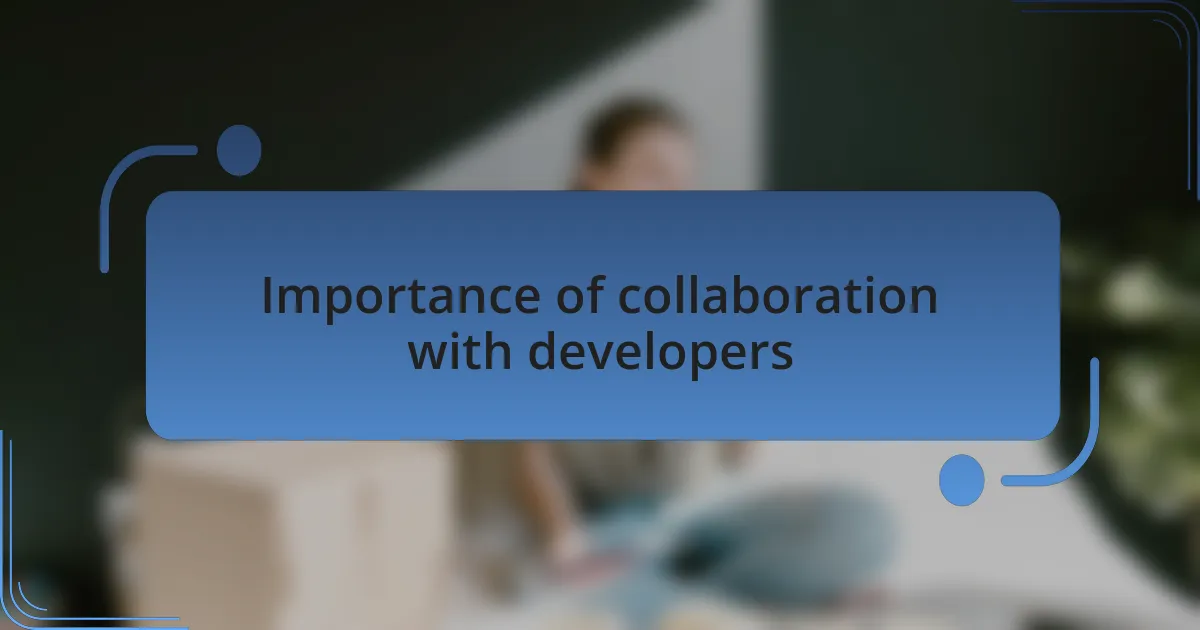
Importance of collaboration with developers
Collaboration with developers is essential for ensuring that a web design project not only looks good but also functions effectively. I vividly recall a recent experience where, during a brainstorming session, the developers brought up potential technical limitations I hadn’t considered. This revelation changed my entire design approach and highlighted how crucial it is to integrate their insights early on. Have you ever had a moment where a developer’s input completely shifted your perspective?
When we collaborate effectively, we reduce the risk of miscommunication, which can be costly down the line. I remember one project where an overlooked detail in the initial handoff led to weeks of revisions. It was frustrating, but it taught me the importance of involving developers right from the wireframe stage. What if we could save ourselves that same headache by fostering an ongoing dialogue throughout the process?
Moreover, collaboration fosters a sense of ownership among team members. I’ve noticed that when developers are involved in the design discussions, they take pride in bringing the vision to life. Once, we hosted a workshop where designers and developers pitched ideas collaboratively. The energy in that room was infectious! Have you experienced a team moment like that, where everyone felt equally invested? It’s in those collaborative efforts that true innovation flourishes.
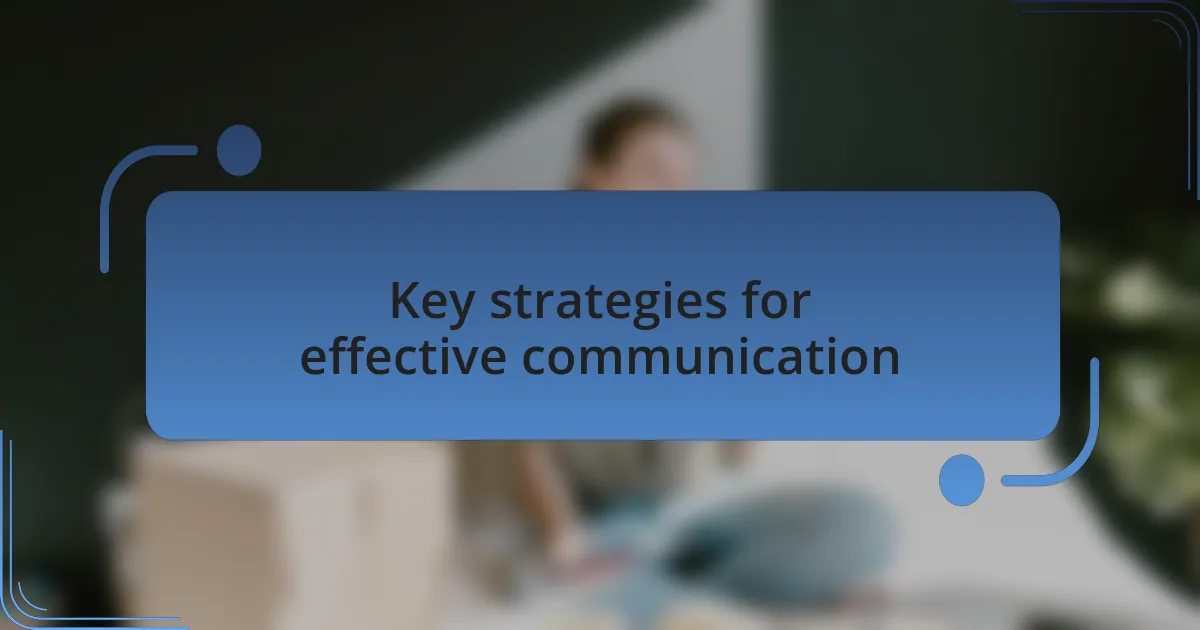
Key strategies for effective communication
Effective communication lays the groundwork for successful collaboration with developers. I’ve found that using specific, jargon-free language makes a world of difference during discussions. For example, instead of using technical terms that might confuse, I prefer to illustrate concepts with visuals or analogies. Have you ever tried explaining your vision through a simple sketch? It’s often the quickest way to bridge understanding between designers and developers.
Regular check-ins are another key strategy I swear by. In one of my projects, I initiated weekly huddles where we shared updates and challenges we faced. These meetings became a safe space for open dialogue, allowing us to address issues before they escalated. I’ve observed that this consistent touchpoint not only keeps everyone aligned but also fosters stronger relationships within the team. Have you considered implementing a similar routine?
Lastly, practicing active listening can’t be overstated. I remember a particularly heated debate over a design feature, where I took a step back and truly listened to the developers’ concerns. By validating their perspectives and integrating their feedback, we reached a compromise that satisfied both usability and aesthetics. Have you experienced the profound impact of simply listening? I’ve realized that when team members feel heard, it naturally enhances the collaborative spirit.
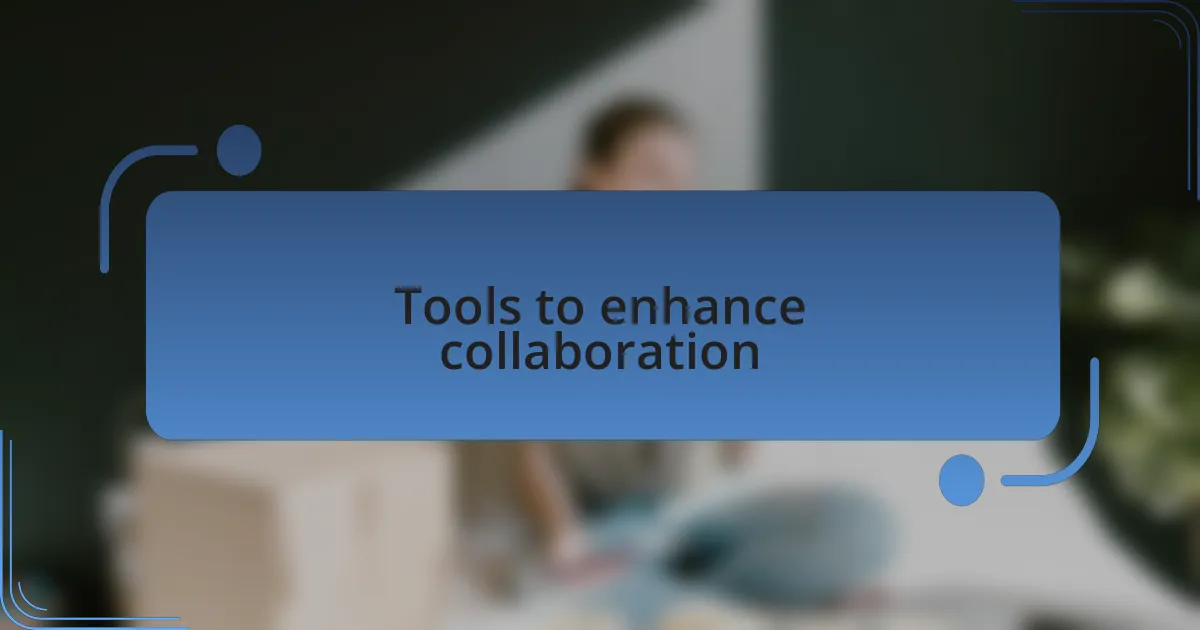
Tools to enhance collaboration
When it comes to collaboration, the right tools can really streamline our workflow. I often rely on platforms like Slack for real-time communication; it’s amazing how a simple message or emoji can clarify a complex idea without overwhelming anyone. Have you experienced the ease of quick chats over long email threads? I think that’s where these tools shine, making us feel connected and responsive.
Another tool that’s become indispensable for me is Trello. This project management software allows us to visualize our tasks and deadlines. I vividly remember a chaotic project where tasks were piling up, leading to confusion. Once we implemented Trello, we could easily track progress and strike off completed items. I’ve found that this visibility helps everyone stay accountable and motivated. Can you imagine how empowering it feels to see your contributions structured and acknowledged?
Moreover, I’ve recently started using Figma for design collaboration, and it has transformed the way I share my ideas. I love how this tool enables real-time feedback; it feels almost like we’re brainstorming in one room. I recall a project where developers were hesitant about a design element. By using Figma, we made quick adjustments based on their input, which not only improved the end product but also created a sense of shared ownership. Isn’t it powerful when everyone feels invested in the final outcome?
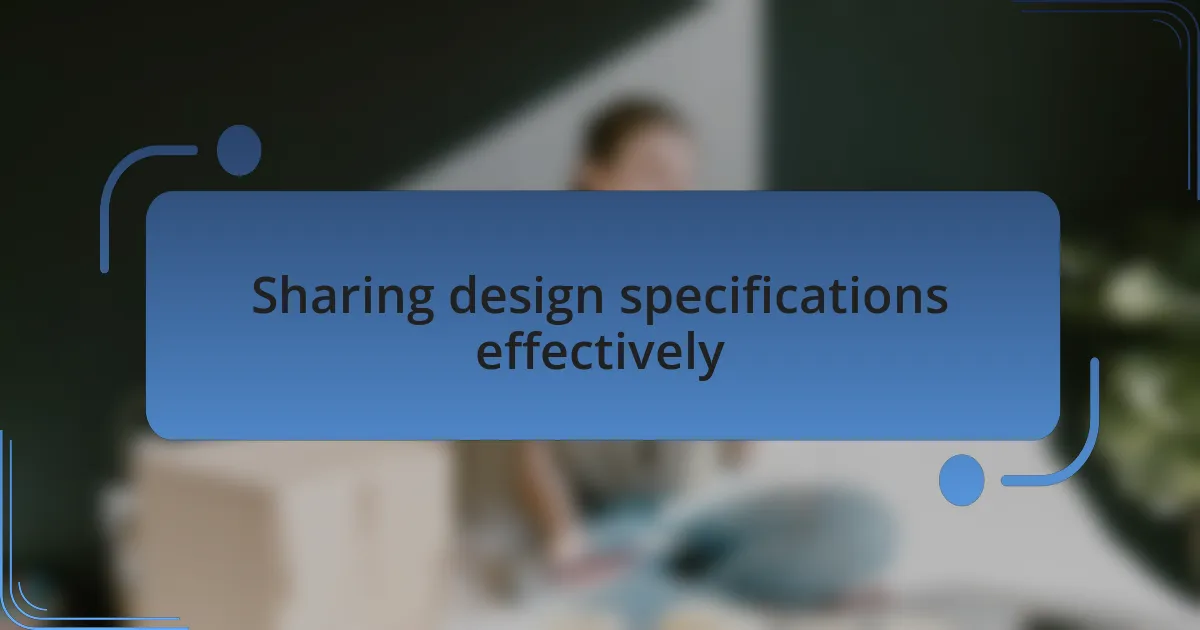
Sharing design specifications effectively
Effective communication of design specifications is crucial for seamless collaboration with developers. In my experience, utilizing detailed style guides has proven invaluable. For instance, during a recent project, I created a comprehensive document outlining fonts, colors, and spacing. This not only ensured consistency across the board but also served as a reference point for developers whenever questions arose. Aren’t precise guidelines a relief when there’s so much to juggle?
I’ve also learned the importance of visual aids. Sharing annotated screenshots or mockups can bridge the gap between design and implementation. I remember struggling to explain a particular interaction in a wireframe until I included a simple video showing the desired flow. The feedback from developers was immediate and positive; I could tell they appreciated having a clear visual to work from. Have you noticed how much easier it is to understand a concept when you can actually see it in action?
Lastly, I find it essential to establish a feedback loop early in the process. Inviting developers to review these specifications not only fosters collaboration but also empowers them to share their insights or concerns. I made it a habit in my last project to hold short check-in sessions specifically for this purpose. It was gratifying when developers pointed out potential usability issues before they became a headache later on. Isn’t it amazing how a little dialogue can lead to better-designed outcomes?
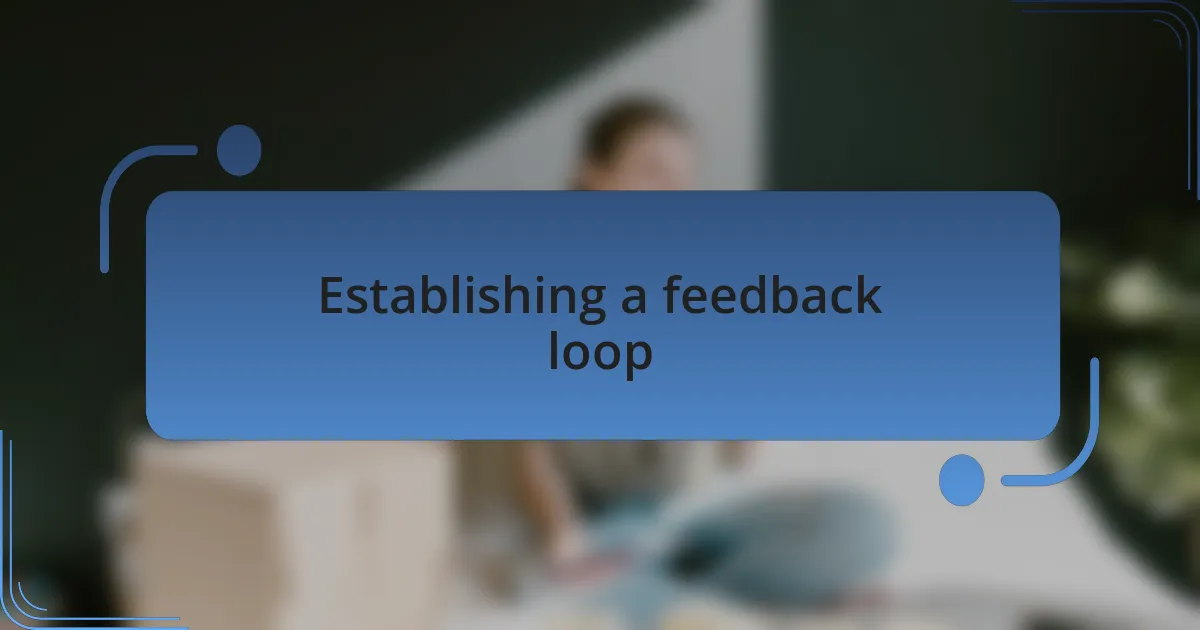
Establishing a feedback loop
Establishing a feedback loop is one of the most effective ways to ensure that both developers and designers are on the same page. I recall a project where we set weekly feedback sessions to discuss the design prototypes. This was a game-changer; it allowed everyone to voice opinions and brainstorm improvements. Have you ever noticed how much clarity a shared discussion can bring?
In practice, I found that real-time feedback tools significantly enhanced our collaboration. For example, using platforms like Figma immediately encouraged developers to leave comments directly on the designs. I remember a developer pointing out a technical limitation that I hadn’t considered, allowing us to pivot our approach before moving too far down the road. Doesn’t it feel great to nip potential issues in the bud?
I also believe in fostering an open culture in these feedback meetings. I once asked a developer to share their thoughts upfront in a team meeting rather than waiting for reviews. The shift was eye-opening—seeing their insights emerge organically created a sense of ownership and respect for each other’s roles. Don’t you find that when everyone feels heard, the overall synergy improves immensely?
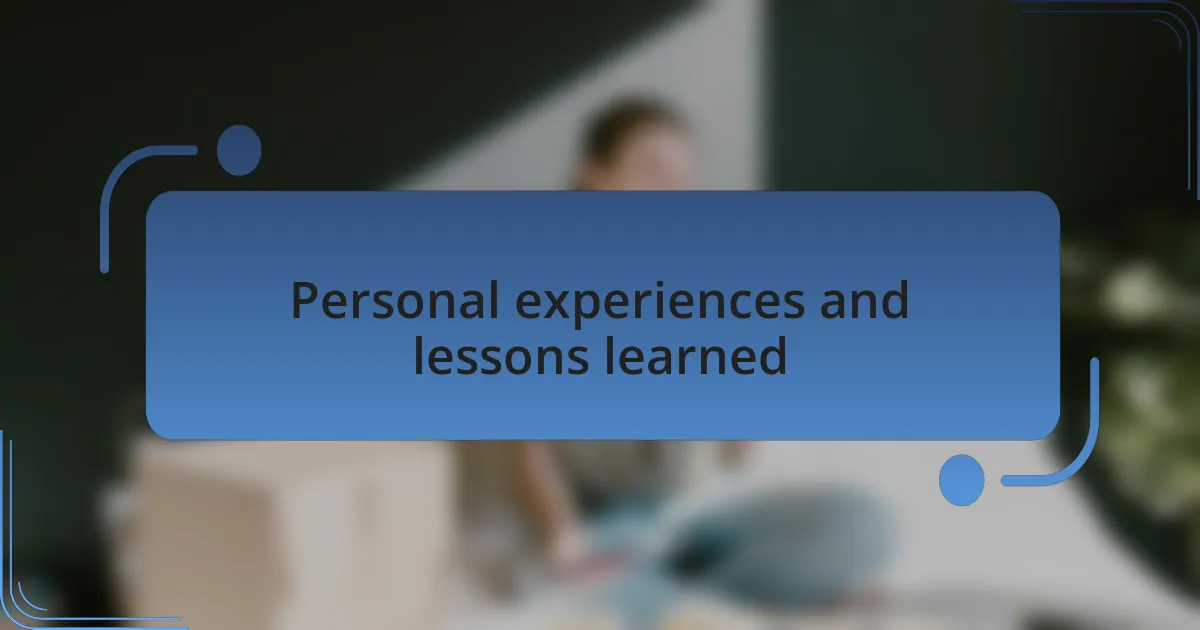
Personal experiences and lessons learned
During one project, I made the mistake of assuming that developers and designers speak the same language. It became apparent when I presented my layout, and their puzzled expressions told me everything. That experience taught me the importance of clarity in communication—when we took the time to define terms and visuals together, it not only bridged gaps but also fostered a more collaborative atmosphere. Have you ever felt the relief of finally being understood?
I still remember the project where we decided to involve developers early in the design phase. Their input shaped the final product significantly. One developer suggested a simpler interaction that made the user experience smoother than I had anticipated. This taught me that collaboration isn’t just about voice; it’s about truly integrating perspectives and ideas—doesn’t that deepen the outcome?
In another instance, I learned the value of celebrating our small victories as a team. After a successful sprint, instead of just jumping to the next task, we took a moment to recognize each other’s contributions. I saw how this simple act strengthened our relationships and boosted morale. Isn’t it powerful how acknowledging effort can transform team dynamics?